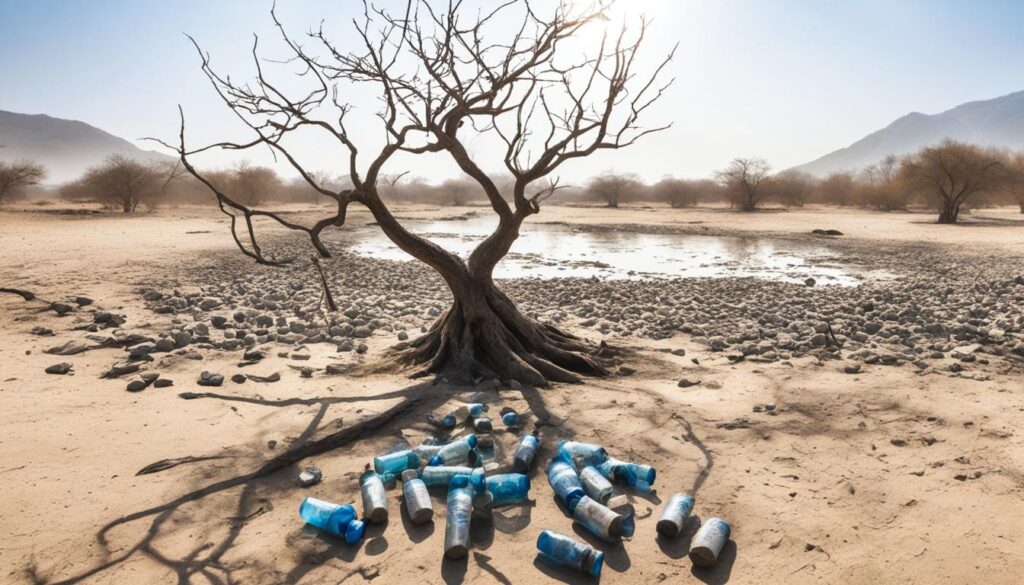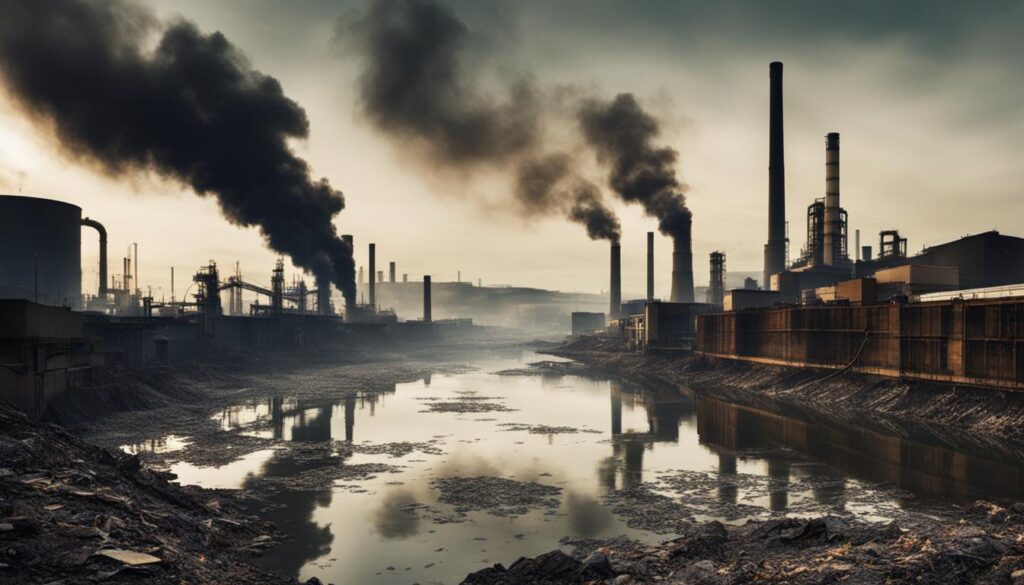Scarcity has a profound impact on consumption and the environment. In the past, there was a belief that being environmentally conscious was costly for businesses. However, this perception has shifted, and being green is now seen as an opportunity for innovation and market growth. With the growing awareness of the environmental impact of overconsumption, sustainability has become a key consideration for individuals and corporations alike.
There is an ongoing debate about the value of green consumption, with critics arguing that it does not address deeper issues of capitalism and overconsumption. While being green is a positive step towards reducing our environmental footprint, it is crucial to recognize the need for a balance between economic concerns and environmental sustainability. It is only by addressing both aspects that we can achieve a truly sustainable future for our planet.
Key Takeaways:
- Scarcity has a significant impact on consumption and the environment.
- Being green is seen as an opportunity for innovation and market growth.
- The debate around green consumption continues, highlighting the need for a balance between economic concerns and environmental sustainability.
- Addressing deeper issues of capitalism and overconsumption is necessary for long-term sustainability.
- Achieving a truly sustainable future requires a collaborative effort from individuals, businesses, and governments.
The Environmental Impact of Overconsumption
Overconsumption of natural resources poses a significant threat to the environment, resulting in detrimental consequences such as biodiversity loss and ecosystem degradation. When resources are consumed at an unsustainable rate, ecosystems struggle to replenish themselves, leading to irreversible depletion and long-term damage.
One striking example of overconsumption’s environmental impact is deforestation caused by excessive timber consumption. This practice has resulted in the loss of millions of hectares of forest land, disrupting habitats and disrupting the delicate balance within ecosystems.
To illustrate the severity of the issue, consider the following facts:
| Type of Environmental Impact | Description |
|---|---|
| Biodiversity Loss | Overconsumption depletes habitats, leading to the extinction of plant and animal species. |
| Ecosystem Degradation | Unsustainable consumption disrupts the delicate balance in ecosystems, impacting natural cycles and processes. |
It is crucial to address our tendency to overconsume in order to protect the planet and preserve essential resources for future generations. By adopting sustainable consumption practices, we can minimize the environmental impact and ensure a healthier and more sustainable future. Through conscious choices in our daily lives, such as reducing waste and opting for eco-friendly alternatives, we contribute to the collective effort of mitigating the negative consequences of overconsumption.
Quotes:
“The overconsumption of natural resources poses a grave threat to our planet’s biodiversity and ecological balance. It is imperative that we shift towards more sustainable consumption patterns to safeguard our environment for future generations.” – Dr. Jane Green, Environmental Scientist
The Consequences of Consumption on Natural Resources
Consumption of natural resources has a direct impact on the environment, as many resources need time to replenish themselves. If natural resources are not consumed sustainably, they can decline or face permanent depletion. Non-renewable resources, such as fossil fuels and mined materials, are especially vulnerable. The consequences of running out of these resources could have severe economic impacts and create a need for alternative sources. It is essential to practice sustainable consumption to avoid further damage to the environment and ensure the availability of essential resources.
When we consume natural resources without considering their limited availability, we contribute to the depletion of these valuable assets. Natural resources, such as oil, coal, and metals, are extracted and utilized at a rate much faster than they can be replenished. The depletion of these non-renewable resources not only threatens the delicate balance of ecosystems but also poses significant risks to industries and economies that heavily rely on them.
Imagine a world where fossil fuels are completely depleted. Our transportation systems, energy production, and manufacturing processes would be severely disrupted, leading to substantial economic and social consequences. It is crucial to recognize the finite nature of these resources and implement sustainable consumption practices to ensure their availability now and in the future.
Practicing sustainable consumption involves using resources efficiently, reducing waste, and prioritizing renewable alternatives. By embracing technologies that harness renewable energy sources like solar, wind, and hydropower, we can reduce our reliance on non-renewable resources and mitigate their depletion. Adopting circular economy principles, which focus on recycling, reusing, and reducing resource consumption, can also contribute to a more sustainable future.
Our planet’s natural resources are not infinite. We must recognize the consequences of our consumption patterns and make conscious choices to protect these valuable assets. It is our responsibility to ensure that future generations have access to the resources they need for their well-being.
By practicing sustainable consumption, we can safeguard natural resources, mitigate environmental degradation, and create a more resilient and equitable future. Governments, businesses, and individuals all play crucial roles in driving this change. Together, we can transition to a more sustainable and resource-efficient society, ultimately preserving our planet for generations to come.

Types of Natural Resources Consumed
In order to understand the impact of consumption on the environment, it’s important to distinguish between non-renewable and renewable resources. Non-renewable resources, which include fossil fuels and mined materials, take millions of years to form and cannot replenish themselves within a reasonable timeframe. On the other hand, renewable resources, such as wind, solar energy, food sources, and lumber, have the ability to replenish at a faster rate.
Non-renewable resources are limited in availability and susceptible to depletion due to their slow formation process and high demand. The extraction and utilization of these resources have significant environmental consequences, including habitat destruction, pollution, and the emission of greenhouse gases.
Non-renewable resources:
Fossil Fuels:
– Coal
– Oil
– Natural gasMined Materials:
– Metals (e.g., iron, copper, gold)
– Minerals (e.g., phosphate, limestone)
– Gemstones
On the other hand, renewable resources have the potential to be sustainably used and replenished. However, it is important to monitor and manage the consumption of these resources to prevent overexploitation and ensure their long-term availability.
Renewable resources:
Wind Energy
Solar Energy
Biomass
– Food sources (e.g., crops, livestock)
– Timber
By diversifying our energy sources and promoting sustainable practices, we can reduce our reliance on non-renewable resources and minimize resource depletion. Transitioning to renewable resources not only helps protect the environment but also offers various economic and social benefits.
In conclusion, understanding the types of natural resources consumed is vital to addressing resource depletion and adopting sustainable consumption practices. By prioritizing the use of renewable resources and implementing strategies to reduce our reliance on non-renewable resources, we can strive towards a future of environmental balance and resource preservation.
Global Variations in Natural Resource Consumption
The consumption of natural resources varies among countries and is strongly influenced by their economic wealth. Wealthier nations tend to have higher levels of natural resource consumption compared to developing countries. This disparity in consumption patterns has significant implications for resource depletion and the environmental impact.
North America, primarily the United States, stands out as the largest consumer of natural resources globally. On average, a North American consumes twice as many resources as a European and nine times more than an African. This stark difference in consumption highlights the influence of wealth on natural resource consumption and its associated environmental consequences.
While wealthier nations have the capacity to consume more resources, it is essential to recognize the impact this has on global resource availability. Excessive consumption depletes natural resources, increasing the risk of shortages and compromising the ability to meet future demands.
The consumption patterns of wealthier nations also contribute significantly to environmental degradation. The exploitation of natural resources for industrial production, energy generation, and consumer goods in these countries leads to habitat destruction, biodiversity loss, and increased pollution levels.
“The abundance of consumption in wealthier nations has both immediate and long-term effects on the environment and poses challenges for sustainable development.” – Global Sustainability Advocate
Addressing global variations in natural resource consumption requires a comprehensive approach that balances economic growth with sustainable consumption practices. This involves promoting resource efficiency, investing in renewable energy sources, and implementing responsible consumption patterns.
Strategies for Sustainable Consumption
To mitigate the negative impacts of natural resource consumption, countries can adopt various strategies:
- Promoting awareness and education on sustainable consumption practices
- Encouraging technological advancements for resource efficiency
- Implementing policies and regulations to promote sustainable production and consumption
- Supporting the development of environmentally-friendly industries
- Fostering international cooperation to address global resource challenges
By prioritizing sustainable consumption, countries can ensure the long-term availability of natural resources, minimize environmental damage, and contribute to a more resilient and sustainable future.
The Impact of Consumption on the Environment
Consumption directly affects the environment, contributing to global warming and the deterioration of ecosystems. Industries reliant on natural resources, such as construction and agriculture, contribute to greenhouse gas emissions and habitat destruction. The overall status of the environment is sensitive to our consumption patterns, and it is crucial to switch to sustainable resources and use them responsibly to protect the planet’s ecosystems.
“The environmental impact of our consumption choices cannot be ignored. From the carbon emissions released during the production and transportation of goods to the deforestation caused by excessive timber consumption, the consequences are far-reaching.”
– Dr. Jane Anderson, Environmental Scientist
One of the major contributors to environmental degradation is the excessive use of fossil fuels and the subsequent release of greenhouse gases into the atmosphere. The burning of fossil fuels for energy production, transportation, and manufacturing processes significantly contributes to global warming. The continuous rise in global temperatures poses numerous risks, such as melting ice caps, increased frequency of extreme weather events, and rising sea levels.
Ecosystem degradation is another consequence of consumption. The destruction of habitats and the loss of biodiversity are direct results of human activities driven by consumer demand. Industries involved in deforestation, mining, and intensive agriculture often disrupt fragile ecosystems, leading to the extinction of species and irreversible damage to the delicate balance of our planet’s ecosystems.

In order to mitigate the environmental impact of consumption, there is a need to transition to sustainable resources and adopt responsible consumption practices. This includes promoting renewable energy sources, reducing waste through recycling and circular economy models, and supporting businesses that prioritize environmental stewardship. By making conscious choices as consumers, we can minimize our ecological footprint and contribute to the preservation of our planet for future generations.
The Role of Sustainable Consumption
Sustainable consumption plays a vital role in reducing the environmental impact of our choices. It involves selecting products and services that have a lower carbon footprint, are produced using renewable resources, and contribute to the overall well-being of both people and the planet. By prioritizing sustainable consumption, we can drive demand for environmentally friendly alternatives and encourage businesses to adopt more sustainable practices.
Furthermore, sustainable consumption involves extending the lifespan of products and reducing waste through repair, reuse, and recycling. Embracing the principles of a circular economy can minimize resource extraction, minimize waste generation, and promote a more sustainable and resilient society.
The Way Forward
Addressing the environmental impact of consumption requires a collective effort from individuals, businesses, and policymakers. Governments must create and enforce regulations that encourage sustainable practices and hold industries accountable for their environmental footprint. Businesses must prioritize sustainability in their operations and supply chains, making conscious efforts to reduce emissions, conserve resources, and preserve ecosystems.
As individuals, we can make a difference by being mindful of our consumption habits and choosing products and services that align with our environmental values. By supporting sustainable brands, reducing waste, and advocating for change, we can contribute to a more sustainable future and protect the planet from further degradation.
The Most Consumed Natural Resources
Water and sand are two of the most heavily consumed natural resources, playing essential roles in various aspects of human life and economic activities.
The Significance of Water Consumption
Water is a vital resource necessary for our survival, as well as for supporting agriculture, industrial processes, and electricity generation.
Its consumption is not only crucial for human well-being but also for sustaining ecosystems and biodiversity.
The Growing Demand for Sand
Sand, on the other hand, is predominantly used in construction, fueling the global urbanization trend.
The demand for sand has surged in recent years, driven by population growth, infrastructure development, and the expansion of cities.
“Sand is used to produce concrete, asphalt, glass, and countless other materials that are essential for construction. However, the extensive extraction of sand from riverbeds, beaches, and other sources is causing serious environmental concerns.”
The Threat of Overconsumption and Climate Change
Overconsumption of water and sand, coupled with the rapidly changing climate, poses significant threats to our environment and ecosystems.
Excessive water consumption can lead to water scarcity, droughts, and the deterioration of river systems, impacting both human populations and wildlife.
Meanwhile, the uncontrolled mining of sand disrupts ecosystems, exacerbates coastal erosion, and compromises the natural balance of river ecosystems.
Managing Consumption for Preservation
To ensure the preservation of these essential resources and mitigate the environmental impact, it is crucial to adopt sustainable practices when it comes to water consumption and sand mining.
Implementing efficient water management techniques, such as water recycling and conservation measures, can help alleviate the strain on water resources.
Similarly, adopting responsible sand mining practices, exploring alternative construction materials, and promoting recycling and reusing strategies can help mitigate the environmental consequences of sand extraction.
Managing our consumption of water and sand is not only crucial for maintaining a sustainable balance but also for ensuring the availability of these resources for future generations.
How Does Scarcity Spending Impact the Environment and Consumption?
Scarcity spending can lead to guilt and shame in spending, as people try to make the most of limited resources. This can impact the environment as individuals may opt for cheaper, less environmentally friendly options. Additionally, scarcity spending can lead to increased consumption and waste, further negatively impacting the environment.
How Does Scarcity Impact Consumption Patterns across Generations?
Understanding scarcity’s legacy transfer between generations is crucial in analyzing consumption patterns. Older generations may have experienced scarcity, impacting their frugal habits. Younger generations, having grown up in abundance, may overspend. Recognizing and addressing these inherited behaviors is essential for financial literacy education and sustainable consumption habits.
Conclusion
The overconsumption of natural resources poses significant challenges to the environment, biodiversity, and our access to essential resources. To ensure a better future, it is crucial that we shift towards sustainable consumption practices. This means closely monitoring our consumption patterns, promoting the use of renewable resources, and implementing regulations to prevent overconsumption and resource depletion.
By taking action now, we can help mitigate the environmental impact of consumption and preserve our planet for future generations. Conservation of natural resources is not just a choice; it is a necessity. Sustainable consumption practices will enable us to strike a balance between meeting our current needs and preserving resources for the future.
It is imperative that individuals, businesses, and governments all play their part in adopting sustainable consumption practices. By embracing renewable energy sources, promoting recycling and waste reduction, and supporting initiatives for natural resource conservation, we can collectively make a positive impact.
Together, we have the power to create a future where sustainable consumption is the norm. By making conscious choices in our daily lives and supporting efforts to protect and preserve our natural resources, we can ensure a healthier and more sustainable planet for generations to come.
FAQ
How does overconsumption impact the environment?
Overconsumption of natural resources leads to biodiversity loss and ecosystem degradation. It depletes resources faster than they can replenish, resulting in permanent damage to the environment.
What are the consequences of consuming natural resources unsustainably?
Unsustainable consumption can lead to resource depletion, particularly for non-renewable resources like fossil fuels and mined materials. This not only harms the environment but also has severe economic impacts.
What are the different types of natural resources consumed?
Natural resources can be classified as either non-renewable or renewable. Non-renewable resources, such as fossil fuels, cannot replenish within a reasonable timeframe. Renewable resources, like wind and solar energy, replenish faster but still require responsible consumption.
How does natural resource consumption vary globally?
Consumption patterns vary by country, with wealthier nations consuming significantly more natural resources. For example, the average North American consumes twice as many resources as a European and nine times more than an African.
What is the impact of consumption on the environment?
Consumption contributes to global warming and ecosystem deterioration. Industries reliant on natural resources, such as construction and agriculture, generate greenhouse gas emissions and habitat destruction.
Which natural resources are the most consumed?
Water and sand are the most consumed natural resources. Water is vital for survival, agriculture, and industrial processes, while sand is primarily used in construction.
Why is sustainable consumption important?
Overconsumption of natural resources has detrimental effects on the environment, biodiversity, and future access to essential resources. Shifting towards sustainable consumption practices is necessary to protect the planet and ensure a better future.

